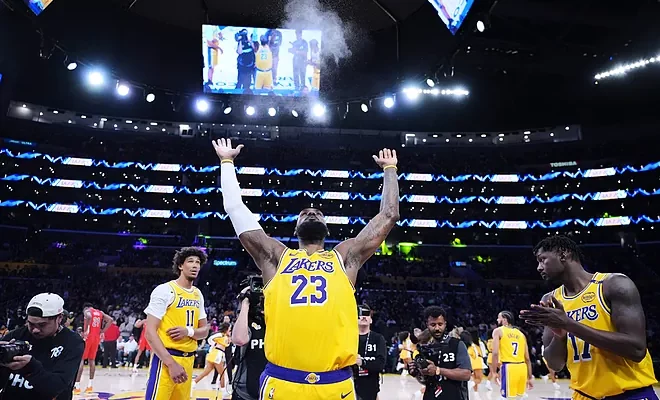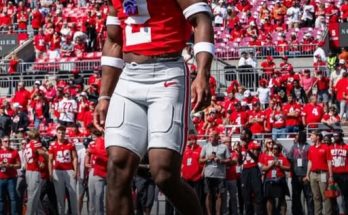LeBron James and Naomi Osaka have long stood as icons in their respective sports—James, the towering figure of NBA greatness whose legacy spans championships, MVPs, and two decades of global influence, and Osaka, the quiet yet powerful tennis prodigy whose Grand Slam victories and mental health advocacy have redefined the modern athlete. So when news broke that the two were teaming up on a unique project aiming to capture an athlete’s off-day, it wasn’t just a creative fusion—it was a moment that offered a candid look into how two of the most scrutinized individuals on the planet find balance, identity, and humanity in a world that often demands relentless performance.
Their collaboration, a multimedia project combining film, digital content, and social media storytelling, is built on a deceptively simple idea: to show the world what it looks like when elite athletes are not training, not competing, and not under the stadium lights. But for James and Osaka, the objective runs much deeper. The project seeks to counteract the often one-dimensional narratives that follow athletes around—the highlight reels, the pressure, the records, the criticism—and instead give viewers a more human, more nuanced, and more empathetic portrait of what it means to be a professional athlete in today’s hyper-connected, high-stakes world.
The collaboration is being spearheaded through Osaka’s production company, Hana Kuma, which she launched with backing from LeBron James’ SpringHill Company. Both ventures are rooted in storytelling that elevates voices and experiences often left on the margins, and this joint endeavor is no exception. The project, described by its creators as “part documentary, part personal diary, and part cultural meditation,” explores how athletes recharge mentally, emotionally, and physically in between the pressure-cooker moments that the public typically sees.
LeBron James, now entering his 22nd season in the NBA, has spoken at length in recent years about the importance of self-care, recovery, and emotional wellness. His off-days often include time spent with family, reading, doing yoga, or simply decompressing at home. For someone who has carried the weight of expectations since he was a teenager, and whose every move is dissected in real time, having control over how he spends his time off is a luxury he doesn’t take for granted. In interviews promoting the project, James emphasized that rest isn’t a weakness—it’s a weapon, a vital component of longevity both on and off the court.
Naomi Osaka, meanwhile, has reshaped the dialogue around mental health in sports, famously withdrawing from high-stakes tournaments to protect her emotional well-being. Her willingness to be vulnerable about the psychological toll of fame and pressure has made her a beacon for other athletes—and a polarizing figure for those who still subscribe to outdated notions of toughness. Osaka’s off-days are often filled with simple pleasures: painting, cooking, walking her dog, or immersing herself in music and Japanese culture. These quieter, introspective moments allow her to reconnect with her sense of self, away from the expectations of the public and media.
The upcoming series doesn’t just show Osaka at home or James with his children—it also delves into the broader themes of identity, culture, and transition. For James, now in the twilight of his playing career, the off-day is increasingly symbolic. It’s not just a moment of rest—it’s a chance to plan what comes next, to mentor younger players, and to find meaning beyond basketball. For Osaka, who recently returned from maternity leave, the off-day is about rediscovery. It’s about finding her footing again, learning how to be both a mother and a world-class athlete, and recalibrating her priorities in a post-pandemic world.
The aesthetics of the project are designed to feel personal rather than performative. Viewers won’t be watching stylized highlight packages or motivational voiceovers. Instead, the visuals will focus on mundane, unfiltered moments: LeBron making breakfast for his kids, Osaka watering her plants, both of them navigating the stillness that often escapes the sports narrative. That stillness, they argue, is where resilience is truly built—not in the roar of the crowd, but in the quiet of one’s own company.
In pairing up, James and Osaka are also bridging generational and cultural gaps. LeBron, the American kid from Akron who became the face of basketball; and Osaka, the Haitian-Japanese tennis star born in Tokyo and raised in the U.S., each bring distinct cultural sensibilities to the project. The result is a celebration of multiculturalism and a subtle critique of how sports media often erases complexity in favor of soundbites and archetypes.
A key element of the project will involve conversations with other athletes who have embraced the power of the off-day, including figures from the NFL, WNBA, soccer, and the Olympics. These guest appearances will serve not just as cameos but as essential pieces of the broader puzzle—showing that the emotional labor of being an athlete is shared across sports, genders, and continents. Everyone deals with burnout. Everyone needs to breathe.
In one of the early trailers, there’s a poignant scene where Osaka sits quietly at a pottery wheel, shaping a lump of clay into something unrecognizable yet full of potential. A voiceover from James muses on the importance of letting things take form naturally—without rushing the process. The metaphor is clear: just as clay needs time to be molded, so too do people. Even those who seem superhuman.
From a business standpoint, this partnership makes strategic sense. James and Osaka are not just athletes—they are brands, moguls, and creators in their own right. Their collaboration expands their portfolios in ways that align with their evolving identities. It also reinforces the idea that the most powerful stories in sports are no longer told only in stadiums—they are told in living rooms, on digital platforms, and in the margins of everyday life.
Critics may argue that such projects are overly sentimental or that they distract from the competition itself. But that critique misses the point. The aim here is not to idolize leisure or diminish the importance of work ethic. Rather, it’s to illuminate the parts of the athlete experience that go unspoken—the parts that involve anxiety, loneliness, healing, joy, and ordinary moments that exist away from the cameras.
In many ways, the timing of this project couldn’t be more relevant. With the pressures on athletes reaching unprecedented levels due to social media, 24/7 coverage, and a cultural obsession with perfection, there’s a growing need for narratives that center mental wellness and authenticity. James and Osaka aren’t just responding to that demand—they’re leading it.
For fans, the project offers a rare gift: the opportunity to see two of the most successful athletes of the 21st century as people first. To see them laugh without a microphone in their face, to see them sit in silence without the world demanding something more. To see them not as performers, but as individuals who navigate joy, struggle, fear, and fulfillment just like anyone else.
As the project moves toward its release date, anticipation is building not just among sports fans, but among educators, psychologists, and creators who recognize the significance of its message. Schools are exploring how the series could be integrated into mental health curriculums. Youth coaches are considering how it might inform their approach to player development. Parents are viewing it as a tool to teach their kids about balance, identity, and the importance of rest.
LeBron James and Naomi Osaka didn’t set out to create a blockbuster or a viral sensation. They set out to tell the truth. And in doing so, they’re offering a version of athletic greatness that doesn’t hinge on statistics, trophies, or iconic moments—but on the courage to be real, the strength to step back, and the wisdom to know that sometimes, doing nothing is the most powerful thing you can do.
This project is not an ending, nor is it a pause. It’s a recalibration. It’s a redefining of what it means to be great, not just on the court or the court, but in the quiet moments in between. In the end, that’s the legacy James and Osaka may be most proud of—not just the victories they amassed, but the space they helped create for others to simply be.



